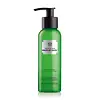What's inside
What's inside
 Key Ingredients
Key Ingredients

 Benefits
Benefits

 Concerns
Concerns

 Ingredients Side-by-side
Ingredients Side-by-side

Water
Skin ConditioningPropylene Glycol
HumectantCarbomer
Emulsion StabilisingGlycerin
HumectantQuaternium-18
Vitis Vinifera Seed Oil
EmollientBehentrimonium Chloride
PreservativePersea Gratissima Oil
Skin ConditioningSodium Carrageenan
Emulsion StabilisingPhenoxyethanol
PreservativeJasminum Officinale Oil
MaskingEthylhexylglycerin
Skin ConditioningPhenethyl Alcohol
MaskingSea Salt
AbrasiveWater
Skin ConditioningAlcohol Denat.
AntimicrobialPropylene Glycol
HumectantGlycerin
HumectantCarbomer
Emulsion StabilisingPPG-26-Buteth-26
Skin ConditioningPalmitamidopropyltrimonium Chloride
PEG-40 Hydrogenated Castor Oil
EmulsifyingQuaternium-80
Parfum
MaskingBehentrimonium Chloride
PreservativeLinalool
PerfumingCitronellol
PerfumingCetrimonium Chloride
AntimicrobialIsopropyl Alcohol
SolventCrithmum Maritimum Extract
Skin ConditioningEryngium Maritimum Extract
TonicLeontopodium Alpinum Callus Culture Extract
AntioxidantSodium Hyaluronate
HumectantCitric Acid
BufferingXanthan Gum
EmulsifyingWater, Alcohol Denat., Propylene Glycol, Glycerin, Carbomer, PPG-26-Buteth-26, Palmitamidopropyltrimonium Chloride, PEG-40 Hydrogenated Castor Oil, Quaternium-80, Parfum, Behentrimonium Chloride, Linalool, Citronellol, Cetrimonium Chloride, Isopropyl Alcohol, Crithmum Maritimum Extract, Eryngium Maritimum Extract, Leontopodium Alpinum Callus Culture Extract, Sodium Hyaluronate, Citric Acid, Xanthan Gum
Ingredients Explained
These ingredients are found in both products.
Ingredients higher up in an ingredient list are typically present in a larger amount.
This ingredient is a preservative and often used for it's anti-static properties. You'll most likely see this ingredient in hair conditioners.
It does not cause irritation or sensitization in leave-on products at 1-5%.
Carbomer is a polymer of acrylic acid. Its main role is to create a gel consistency.
A high amount of carbomer can cause pilling or balling up of products. Don't worry, most products contain 1% or less of carbomer.
Glycerin is already naturally found in your skin. It helps moisturize and protect your skin.
A study from 2016 found glycerin to be more effective as a humectant than AHAs and hyaluronic acid.
As a humectant, it helps the skin stay hydrated by pulling moisture to your skin. The low molecular weight of glycerin allows it to pull moisture into the deeper layers of your skin.
Hydrated skin improves your skin barrier; Your skin barrier helps protect against irritants and bacteria.
Glycerin has also been found to have antimicrobial and antiviral properties. Due to these properties, glycerin is often used in wound and burn treatments.
In cosmetics, glycerin is usually derived from plants such as soybean or palm. However, it can also be sourced from animals, such as tallow or animal fat.
This ingredient is organic, colorless, odorless, and non-toxic.
Glycerin is the name for this ingredient in American English. British English uses Glycerol/Glycerine.
Learn more about GlycerinPropylene Glycol is an odorless, colorless liquid. As a humectant, it helps skin retain moisture. It also aids in delivering active ingredients.
Another role of this ingredient is preventing a product from melting or freezing. Propylene glycol also adds antimicrobrial properties to a product, elongating product lifespan.
This ingredient is considered an organic alcohol and commonly added into both cosmetics and foods.
Those with sensitive skin or conditions may develop a rash when using this ingredient.
Learn more about Propylene GlycolWater. It's the most common cosmetic ingredient of all. You'll usually see it at the top of ingredient lists, meaning that it makes up the largest part of the product.
So why is it so popular? Water most often acts as a solvent - this means that it helps dissolve other ingredients into the formulation.
You'll also recognize water as that liquid we all need to stay alive. If you see this, drink a glass of water. Stay hydrated!
Learn more about Water